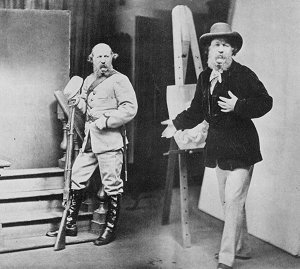 |
n 1860 many people thought that
there could be an attempted invasion from France
| because Louis Napoleon’s intentions
towards Great Britain were unclear. This led to the
formation of the Volunteer Movement, a sort of dad’s army,
which was mainly composed of the middle and professional
classes. |
|
|
Rejlander joined the 1st Wolverhampton Volunteer Company, possibly because
of an interest in the army due to his father’s career as an officer in the
Swedish army and possibly because of his interest in guns. He was a first class
marksman.
The Wolverhampton Chronicle of 20th November 1861 mentions
Rejlander’s shooting prowess. He scored 8 points by firing five rounds at 250
yards on the rifle range at Wightwick and was listed as a member of the 1st
Wolverhampton Company of the 5th Staffordshire Volunteers, formed in
July 1860. In the competition he won the first prize of £5. All of this is put
together in the photograph he took in London in about 1871 called "OGR the
Artist Introduces OGR the Volunteer".
|
|

OGR the Artist Introduces OGR the
Volunteer. |
His time spent at Wolverhampton included the
critical period in which he learnt his skills in photography and
pioneered the technique which is now taken-for-granted, of
making composite positives from several negatives. He decided to
leave Wolverhampton in 1862 and set up a studio in London, which
is where most of his professional contacts were found. This was
recorded in an advert in the Wolverhampton Chronicle on 9th
April. It stated that Mr. O.G. Rejlander respectfully informs
the ladies and gentlemen whose photographic portraits he has
taken, that they may have the negatives at a small price, and
also remaining copies on hand at a reduced price, if applied for
during the next fortnight, as he is leaving this neighbourhood. |
| Selections of his large collection of art
studies, mounted and unmounted, may also be obtained at very low
prices prior to his removal. It also stated that Mr. Rejlander
takes this opportunity to express his regret at leaving his
friends in Wolverhampton, where he has spent the better part of
his life, and will be happy to see them again at his Gallery, 5
Haymarket, London. |
 |
|
 |
|
 |
|
Return to the previous page |
|
Return to the beginning |
|
Proceed to the next page |
|
|